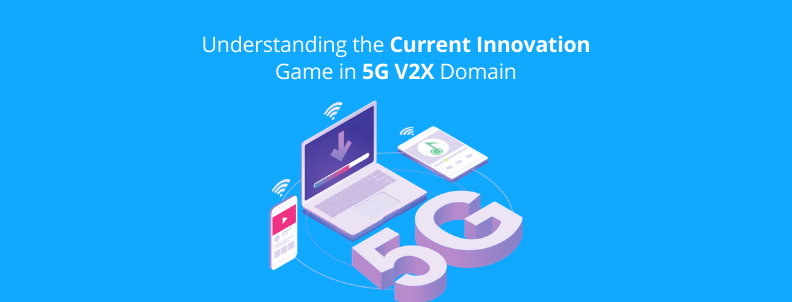With the exponential improvement in innovations in the communications domain, the cars of today are becoming increasingly connected – both with each other and the environment. V2X, which stands for ‘vehicle to everything’, is the umbrella term for a car’s communication system, where information from sensors and other sources travels via high-bandwidth, low-latency, high-reliability links, paving the way to fully autonomous vehicles with the help of 5G.
5G Automotive Association (5GAA) defines its purpose to increase road safety, traffic efficiency, and energy savings. Thus, with the rise of 5G technology, companies are ramping up their developments in various areas that have been birthed by it, and V2X is one of those hotspots today.
We feel that analyzing a company’s patent portfolio early on can suggest various highly probable directions that a company might take when it comes to making business decisions in a particular domain in the future. This article covers some patents that have been recently analyzed by us, which we feel are important developments in the 5G V2X area. It also aims to relate various companies’ research activities with their current business goals in the 5G V2X communication.
The essentiality of the declared 5G V2X/D2D SEPs can’t be confirmed at this point, simply because the technical specifications covering this domain are still under development. But, there is a high probability that these patents will prove to be essential to 5G standards – a claim which is supported through multiple technical reports by 3GPP highlighting how these patents will directly be used in technical specifications in the future.
Majority of the V2X/D2D patents which were analyzed mostly focused on improving interconnectivity, communications speed, and latency. For example, Ericsson’s US10348444B2 focuses on reducing latency through adaptive transmission formats based on vehicular speed. This patent might even prove to be essential to 5G as indicated by Technical Reports 21.866 and 38.812. A similar case is US9572193B2 by Nokia for Quality of Service improvement in the D2D communication scenario which might also be essential to the standard as indicated by TR 21.915. US10299235B2 and US9877337B2 by LG reduce overhead and efficiently mitigate interference respectively.
Notable Patents for 5G V2X Communication
While most of the patents innovate around improving communications in a V2X/D2D setting, there are some other notable patents that we have come across during our analysis. These patents particularly indicate their respective assignees’ business goals in V2X, as shown in the examples below:
- Samsung’s US10397297B2 claims a method where an apparatus determines whether to perform an adaptive VR streaming service based on a bandwidth state. The apparatus requests image data (or video) based on pre-collected head tracking and bandwidth information. Another potential SEP, indicated by TR26.918. The problem this patent particularly resolves is that it enables the provision of different quality content for each viewing angle, to overcome interruptions caused by bandwidth shortage.
Samsung’s declaration of this patent as a 5G standard-essential makes sense. Recently, it was announced that Samsung was working on the world’s first remotely controlled 5G car via VR, and this patent does seem to fit into the grand scheme of 5G plan Samsung has laid out for itself.
- Nokia’s developments seem towards setting up the infrastructure to accommodate 5G cars, a claim supported by US20180224846A1 which assists with the drivability of an autonomous vehicle. This involves detecting specific road traffic conditions and transmitting the information to other vehicles in the area to avoid accidents and controlling vehicle speeds by setting the cars in high alert mode. US9955484B2 uses location/position information of the mobile radio device to select radio resources which are to be allocated to user devices for communication.
Developments like these are in line with the plans revealed by Nokia to provide solutions “for improved traffic safety and cooperative, connected and automated mobility”.
- Qualcomm’s strategy looks a bit different than Samsung and Nokia. They are partnering with Chinese firms to deploy V2X solutions, one of those firms being Datang Telecom Group, a.k.a. China Academy of Telecommunications Technology. The patent CN108347781B by CATT describes how vehicles can communicate “automatic assistance information” with each other when a fleet of autonomous vehicles operates on the road.
Another interesting patent is CN106604338B, which focuses on improvement in communications with UAVs in a region with densely packed macro base stations. Patents like these can prove to be important, assuming how UAV based delivery systems have suddenly gained pace and 5G compatibility with such delivery systems will be a key factor in such a system’s success. Thus, Qualcomm’s involvement in 5G will most definitely not be limited to providing solutions in few V2X related areas, but also go beyond what one might think of when it comes to the understanding of the word “vehicle”- owing to how Qualcomm is partnering with different firms and bringing solutions to different spheres of V2X domain.
As it turns out, our analysis has shown only the “big players” in the communications industry filing for SEPs in the V2X domain. It is important to also realize, however, that the ocean is blue and V2X offers great opportunities for SMEs and individual inventors to capitalize on it. Cars and 5G will go hand in hand, with explosive growth in the coming future. If we can recognize gaps and predict what steps a company could take in an innovation space, it can give you that competitive edge.
Want our help in gaining a competitive edge in the V2X domain? Fill the short form below and our team will revert in no time.
Authored by: Sparsh Gupta, Patent Infringement.











